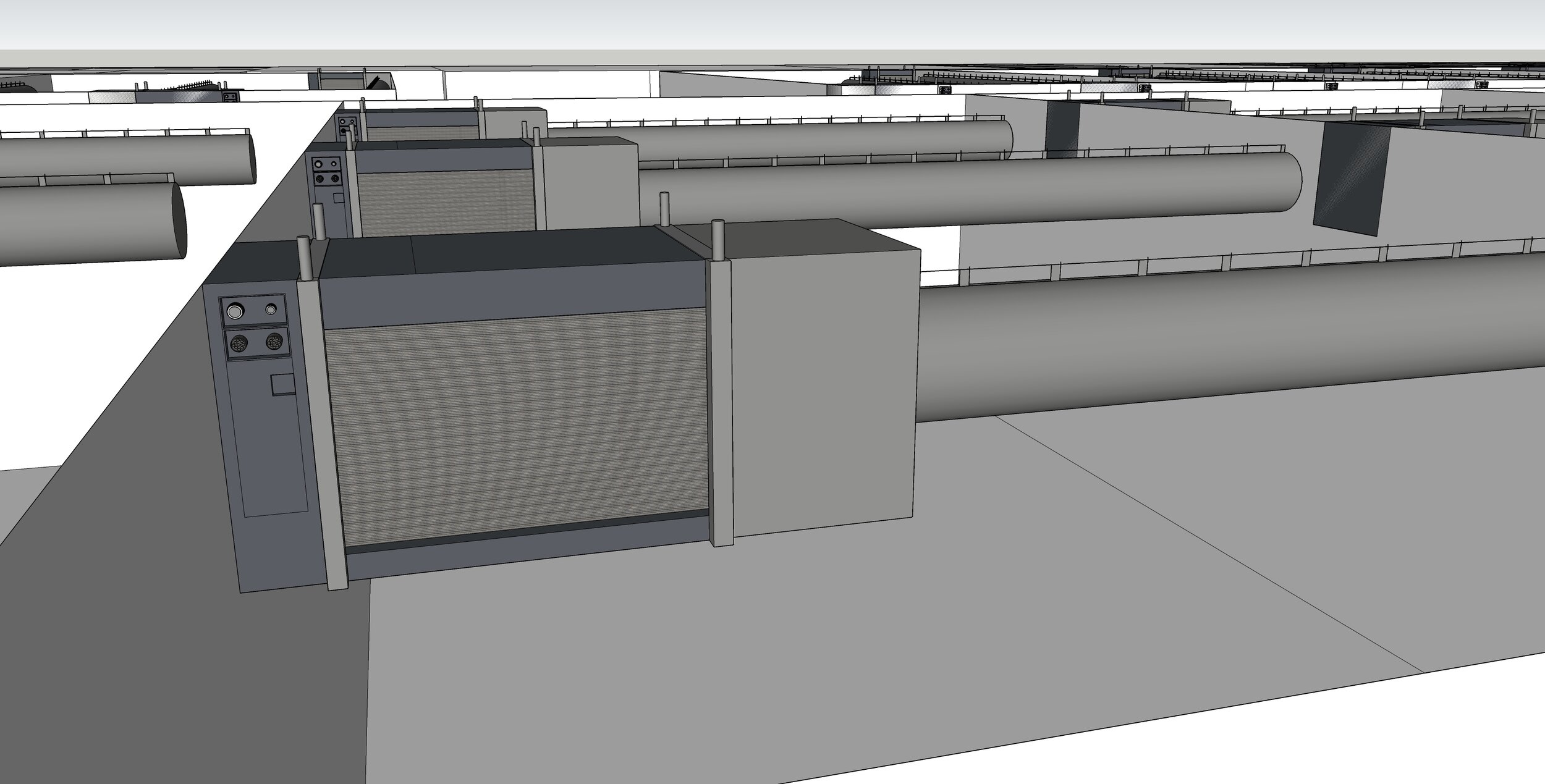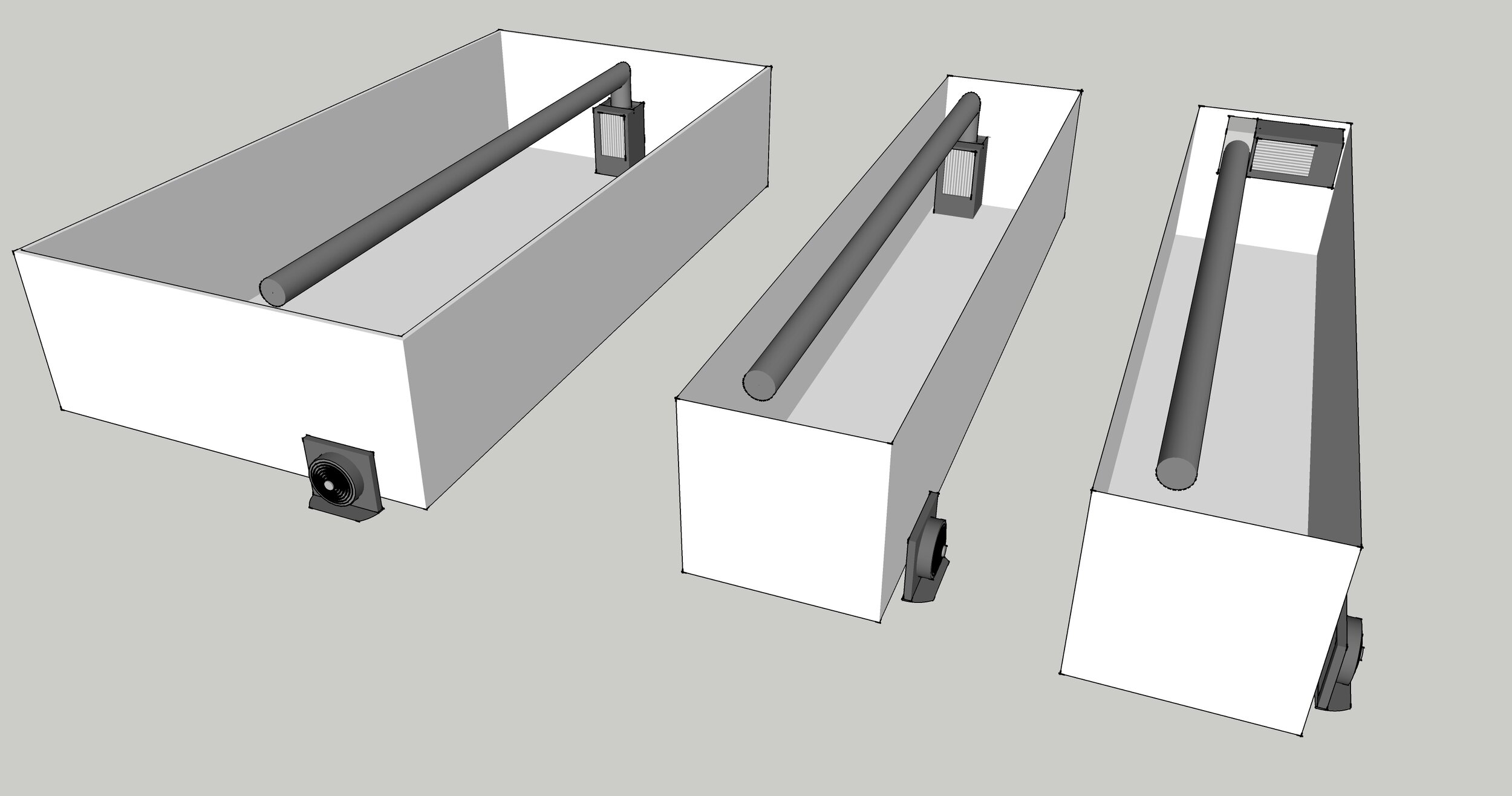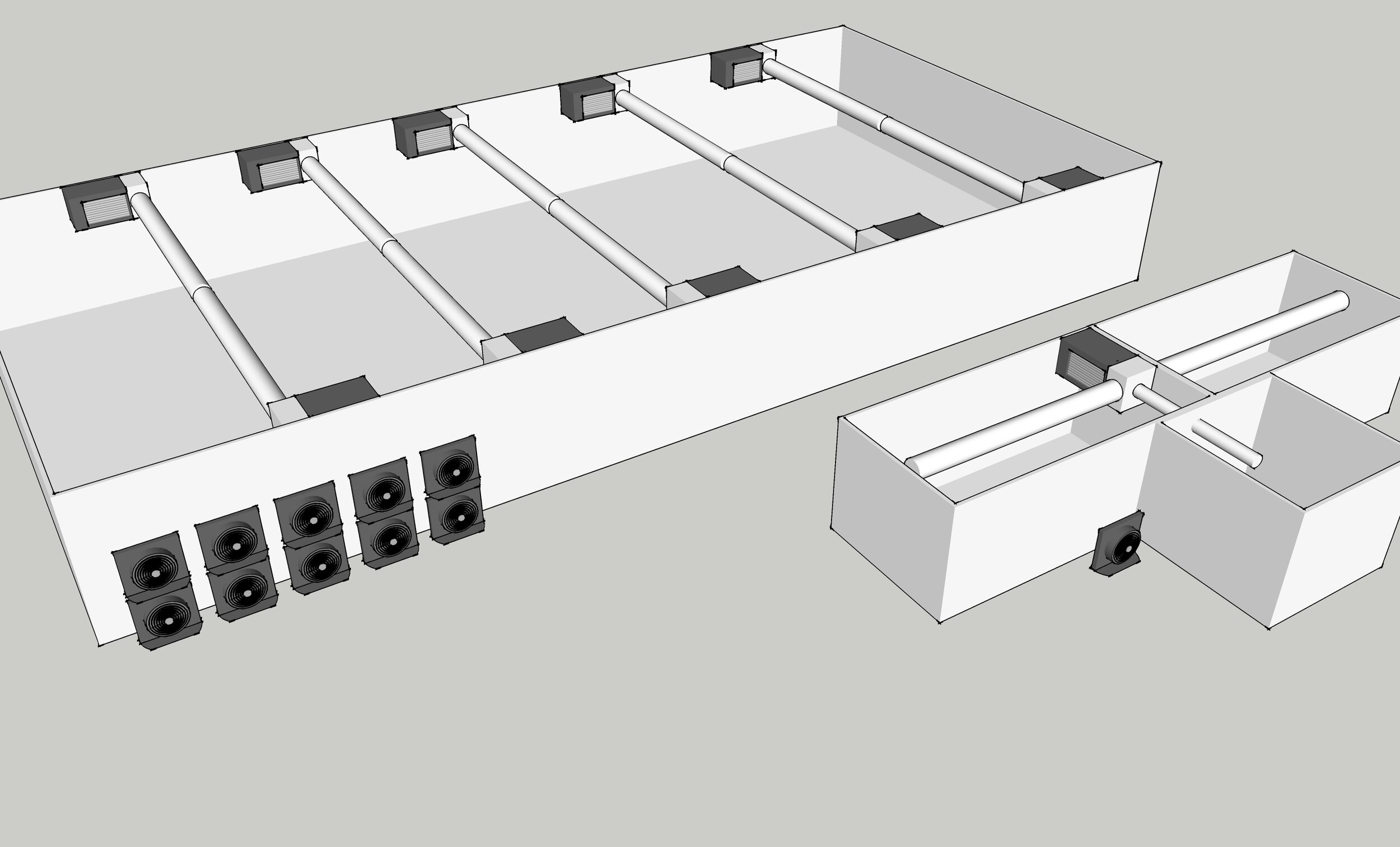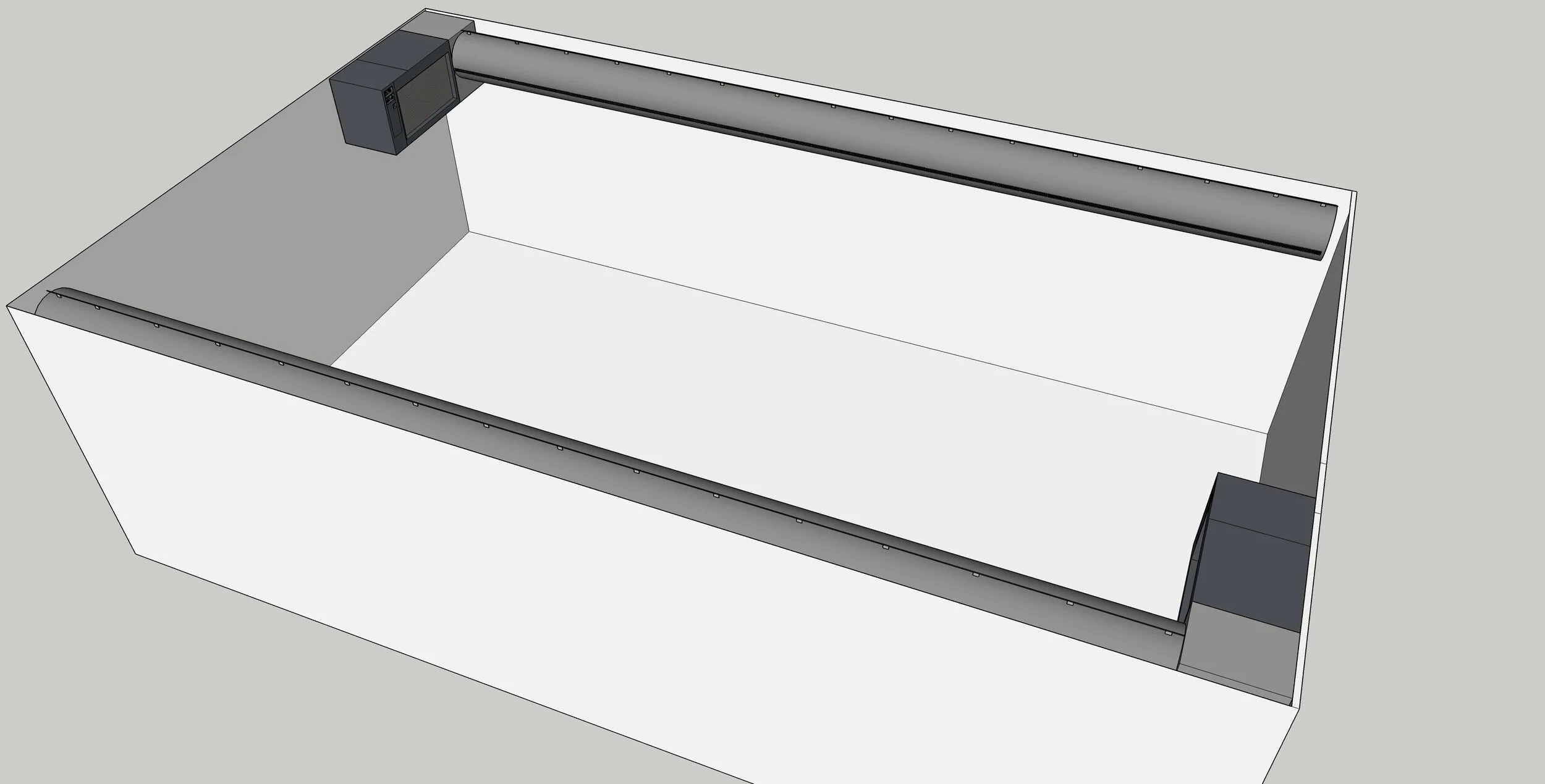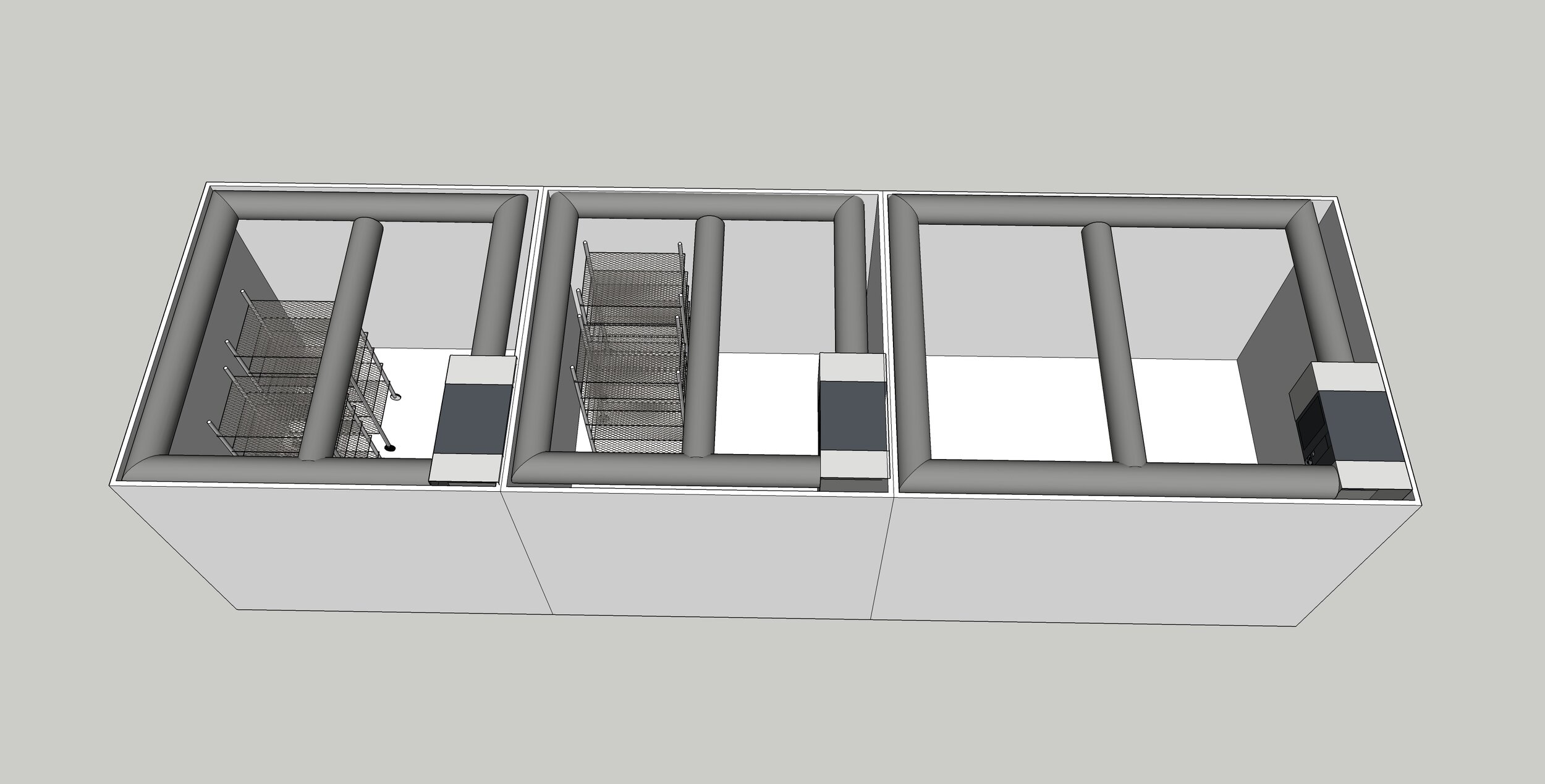Product Selection
When selecting equipment for a facility, it’s important to take many variables into consideration, including lighting loads, feeding requirements, space/density, workflow, and scalability. At Excel Air Systems, we believe innovation is taking complex things and making them simple, so we recommend having all systems directly in the room. This eliminates a lot of additional mounting requirements and static pressure drops for greater simplicity of installation.
We offer free 3D room designs for spatial understanding to scale, allowing both you and your customer to be on the same page before producing drawings that could be dramatically revised repeatedly. One of the most important traits an engineer/designer must have is the ability to think more variably, as these are living plants and therefore constantly changing. It’s also important to plan for the hottest day in the summer without grossly oversizing things, since this can otherwise have adverse effects on maintaining the environment and the bottom line.
Knowing the numbers
Heatloads
Since most facilities share a lot of commonalities in lighting solutions, environmental control, and plant selection, looking at an average across these segments is the best course of action before going into further detail. When it comes to temperature, humidity, and air quality control, the most important factor is always heat load. It’s important to know what the maximum heat load is, with lighting, pumps, wall fans, CO2 burners and additional BTU creation.
With this number determined, we then build on the plan from there. As technology continues to advance, LED lighting has slowly started to replace traditional HPS lighting. However, most LED lighting adoption is still only at the veg stage, and not the flower stage, as intensity and cost continue to be a major factor.
typical lighting output (Watts)
The four (4) lights illustrated above represent the majority of the lighting selected for growing cannabis in an indoor environment.
DE CMH (Double Ended Ceramic Metal Halide) is somewhat of a niche product as it’s not as intense – which is why it draws roughly 615 W and can also require more lights per room – but it can demonstrate a very high-quality end product.
LED lights have been taking a greater share of the market as the technology continues to evolve, only recently reaching its total use abilities, even in the flower stage, where its intensity has typically been a bit shy. We generally see most LED lights at comparable footprints (16 - 25 sq. ft.) run on an average 25% reduction in electricity, but costs continue to be a major factor, along with intensity.
Standard HPS (High Pressure Sodium), having been widely used for decades, is the most-cost efficient. As a single bulb at 1000 W, it delivers a broad spectrum and is a great basic option.
DE HPS (Double Ended High Pressure Sodium) utilizes two 615 W bulbs to produce up to 1250 W total output, leading to the highest intensity of light. With such intensity comes overall power output and heat – at times too much, but by far the most popular selection in most facilities.
Recommendations
As a rule of thumb, we recommend 3,000 W of heat load for every ton of air conditioning. We understand that there are 3412 BTU’s per 1000 W of heat. However, several other factors, which can play a significant role, must be taken into account. This is why we estimate roughly 15% to encompass insulation values, summertime temperatures, and changing humidity loads. This is an average that works extremely well to cover a variety of set-ups and conditions in facilities across the United States and Canada.
Unfortunately, we cannot use the benefit in the evaporative cooling effect, when plants are at their highest transpiration rate, as this is not the case at the beginning of the plant cycle. For greater detail, please see the corresponding graphs in the section below.
Our general recommendation is the following;
3,000 Watts of heat load = 1 Ton of capacity required
All values are based on 80 - 85 °F outdoor ambient temperature with R-12 insulation or better
Using these values, you will maintain a 78 - 80 °F room temperature with 50 - 60% RH during the day cycle
Plant Cycle
Although each master grower likes to maintain their own temperatures and humidity preferences, the above chart is an average representation for most rooms under normal circumstances.
When a clone is taken from a mother plant, it is placed in a dome that will keep the cutting warm and wet for a handful of days. At this point, roots will begin to grow. Once enough roots have begun to develop, the baby will be transplanted to a medium-sized pot to further vegetate under 18 hours of lighting.
The plant will then grow, on average, for 1 - 4 weeks, depending on both the strain and how large the grower desires the finished plant height to be.
Obviously, less time pre-vegging will lead to a smaller, denser plant, while a longer period will result in larger plants. It’s really up to the master grower. Once the plant is “flipped” meaning they will start to receive 12hr light cycles this will encourage bud development to begin and start the countdown to harvesting which can be on average 6-10 weeks depending on the type of plant. Overall keeping the room consistent is the absolute most important factor, and setting wider headbands general helps to roll your curves rather than have peeks and valleys. Also, sunrise and sunsetting can assist in smoothing out the start/end of day cycles.
Avg. Transpiration Rate of plant through cycle
Each strain can vary a lot in terms of overall size and attributes all contributing to a unique potential for transpiration. As there are three (3) origin types of cannabis (sativa, indica and ruderalis) each of these strains can be crossed with each other to provide attributes the other may be missing. Ex. Indica is more known for it’s body stone where sativa is more uplifting so crossing two plants can give you a mixture of the two. Then within the three main origins you will hundreds or thousands of varieties all providing unique flavour, profile and capabilities.
The chart above is based on an indoor room with roughly 10-13 plants per light (15-20sqft). Another approach when considering humidity load is to see what the master growing is looking to feed as this will be the absolute maximum the plant will transpire but even within that context you want to account for the type of growing medium (soilesss, hydroponic, cocoa, rock wool etc..) as they can hold more/less moisture depending on the environment. These numbers will put you close in most rooms throughout their cycle.
Humidity Recommendations
There are many variables to consider but the most important is what does peak feeding/growth look like in terms of overall moisture in the sealed room at any given time. As a rule of thumb we recommend the following;
400 Pints of dehumidification per 250-300sqft / 15 x 1,000W equivalent lights.
This is assuming 2-2.5lbs of dry yield per plant
Average room will maintain 50-60% day cycle humidity
Keep in mind adding large dehumidifiers to any space can add large heatloads of over 1500W per unit that must be factored into overall heatload.
Drying/Curing Rooms
Dehumidification Performance
For an average 7-14 day dry cycle you will want to factor a fairly constant decrease in moisture removal, as the humidity drops in the room so does the performance as it takes a lot more effort to drive down the humidity in the space. This works out well however because it takes time for moisture deep within the bud to makes it’s way to the outer layer. This is why drying times under a week run the risk of rot/mould. For sizing the appropriate capacity dehumidification system we want to calculate estimated dry weight from crop and multiply x 4 (20% dry weight and 80% water weight) which tells us how many pounds of water will need to be removed. 1 Pint of water = 1.04lbs. We then take the total water weight / 1.04 = Pints needing to be removed. Then divide by 7 days to get an idea of what your average pints per day requirement will be and select a system that can hit that target at 50% humidity on the chart. Keep in mind we're not going to remove absolutely everything and other variables such as type of drying configuration (only bud, hang drying, screens), ambient conditions with doors open, how well sealed the room is etc.. can vary quite a bit.
Hanging full plants can add up to 50%+ more drying time depending on the size of the plants and the amount of moisture they are retaining.
A rule of thumb is 100lbs per Ton of dry product in 7-10 days under most conditions. We see many facilities extending the drying cycle an extra few days at the end to get it just right, adjusting the humidity levels daily.
Airflow will become the most important aspect of your Dry/Cure Room as you want as much airflow as possible without directly hitting the product as this can lead to the outside of the bud over drying while the inside is still wet. We have many options available and offer free 3D room designs to illustrate these different configurations.
Check out our link below for more information.
Airflow Management
When designing a grow room airflow is extremely important for removing hot/cold spots throughout the room as microclimates can emerge as well as mitigating mould, mildews and any other airborne pathogens. When designing spaces we recommend one complete air turn every 1-3 mins. With the increased airflow it’s important to use engineered ductwork. We recommend our fabric ducting solutions as they are engineered to disperse the air evenly down the length of the duct at 1500 FPM. Additional benefits of our ducting;
1.5lbs per linear foot
Quick and efficient installation utilizing aircraft cable techniques
Machine washable
Permeats 2 CFM around the entire duct for no buildup of dirt/debris and will not condensate
Static Pressure Indoor Blower
dB rating indoor blower
Outdoor Axial Fan Curve
Want in-depth information about ducting design?
Specifications
All Evolution Series systems are ETL listed to UL 1995:2011 Ed.4 and CSA 22.2#236:2011 Ed. 4
SUPPLEMENTARY MATERIALS
Literature
Evolution Series Design Guidelines
Evolution Series Installation Instructions
Cut Sheets
Evolution Series 3-Ton (Horizontal)
Evolution Series 3-Ton (Vertical)
Evolution Series 4-Ton (Horizontal)
Evolution Series 4-Ton (Vertical)
Evolution Series 4-Ton (Horizontal) 460 V 3-Phase Intertek Certification
Evolution Series 5-Ton (Horizontal)
Evolution Series 5-Ton (Vertical)
Submittal Drawings
Evolution Series 4- & 5-Ton (Horizontal)
Evolution Series 4- & 5-Ton (Vertical)
3D Systems Models
Evolution Series 4- & 5-Ton Air Handler
Evolution Series 4- & 5-Ton Condenser
unlock capabilities
As our systems will be able to control temperature and humidity we can also leverage the equipment to add additional capabilities such as UV Air Purification, Filtration and Odor Control.
UV Air Purifier
Can be integrated into any of our systems as it will operate on the systems 24V power and is recommended to run 24hrs a day with the fan. Having so many air turns per hour will add to it’s efficiency in killing spores, bacteria like powdery mildew. The bulbs operate in the 254nM wavelength which is a UV-C germicidal bulb and are dual shielded for 2 years of continuous operation.
CleanAir Filtration System
We offer the robust CleanAir Filtration System, designed for rooms of 30 lights or greater. It comes complete with 55 lb of coconut charcoal and is rated up to Merv 15 filtration efficiency.
Flexible Linesets
System installation and scalability can be dramatically improved utilizing our 2nd generation quick connect flexible linesets. They come in pre-charged 25’, 50’ and 75’ lengths ready to be connected to any Evolution Series system. We recommend every system be upgraded with this feature as it will limit potential contaminants from entering the system during installation, can be easily routed for quick installation and are completely plug and play.
Inspiration
FAQ
Why is 5 Ton the largest system we manufacture?
Redundancy, Airflow Management and Scalability. Having 10 x 5 Ton systems rather than one 50 Ton system provides us 10% increments in which to efficiently use power, dehumidify and easily address any system issues. It maximizes the airflow from each system, reducing overall duct requirements and evenly distributes weight from an engineering load requirement. Additionally, installation is simple and efficient with each system being identical to the next and if expansion is required, adding an additional system should be no issue.
What sizes and Phase and Voltages to you offer?
All of our systems are offered in 2, 3, 4 and 5 Ton capacities in both 1 & 3 Phase at 230V with special order 460V
How do we Mass Dehumidify?
Our Evolution Series Cooling/Dehum models come with a second microchannel slab coil that acts as a reheat coil when dehumidification mode is engaged. The hot gas that would normally be directed to the outdoor condenser in cooling mode is redirected via a reversing valve that “on the fly” goes to the secondary evaporative coil, reheating the air, allowing the unit to remove significant amounts of humidity from the space. When the system switches from cooling to dehumidification mode the compressor does not shut off and there is no freeze/thaw cycle providing full capacity 24hrs per day.
What are the benefits of the quick connect fittings?
Having the fittings on all of our systems dramatically reduces installation time as there is no brazing required. Having fittings on all the system components also reduce installation error such as non-condensables or contaminants in the system as well as all pressure checks and critical charges are done in the factory. This dramatically reduces costly installation time and challenging issues that can stem from these issues. The quick connect fittings can be connected/disconnected many times without losing charge making it ideal for component swaps if necessary. All our Gen2 quick connect fittings can be connected by hand as they are ball bearing and designed for R410A refrigerant. Check out our video to see how these connections are made.
Why use Fabric Ducting over hard duct?
When it comes to sealed rooms specifically indoor cannabis production airflow is key as hot and cold spots can be major issues contributing to temperature and humidity issues. Utilizing Fabric Duct allows us to provide the client with an engineered solution that will evenly distribute air the length of the duct. Installation time and difficulty is dramatically reduced due because of the aircraft cable with quick clips and very lightweight. All ducts are UL rated with fire ratings and are machine washable for food safe production and GMP requirements.
We respect your privacy.
Please refer to our Privacy Policy for more information.



